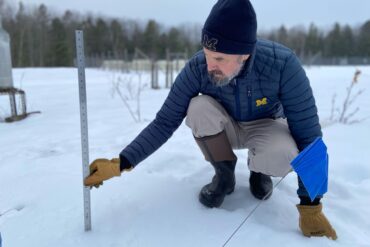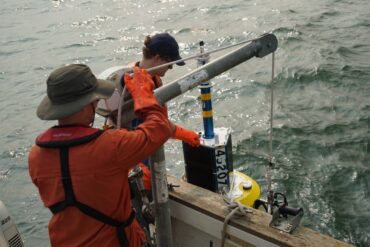-
 CollaborationFeature HomepageForests and PlantsGreat Lakes News CollaborativeInvasive SpeciesLake ErieLake OntarioLatest NewsNewsResearch, Data and TechnologyScience, Technology, ResearchWater Quality and Restoration Efforts
CollaborationFeature HomepageForests and PlantsGreat Lakes News CollaborativeInvasive SpeciesLake ErieLake OntarioLatest NewsNewsResearch, Data and TechnologyScience, Technology, ResearchWater Quality and Restoration EffortsFinding creative new ways to manage invasive cattails
-Scientists are thinking holistically about biodiversity, sustainability, and resilience when it comes to the role invasive cattails play in the Great Lakes.
02 -
 Feature HomepageGLNCGreat Lakes News CollaborativeLatest NewsMinnesotaNewsResearch, Data and TechnologyScience, Technology, ResearchWater Quality and Restoration Efforts
Feature HomepageGLNCGreat Lakes News CollaborativeLatest NewsMinnesotaNewsResearch, Data and TechnologyScience, Technology, ResearchWater Quality and Restoration EffortsThrough a Glass Darkly
-Antidepressants can affect reaction times in fish and birth control gives male specimens female traits. How might pharmaceutical pollution impact life around the Great Lakes?
-
 DetroitFeature HomepageLatest NewsMichiganNewsResearch, Data and TechnologyScience Says WhatScience, Technology, Research
DetroitFeature HomepageLatest NewsMichiganNewsResearch, Data and TechnologyScience Says WhatScience, Technology, ResearchThe solar eclipse is a great opportunity for students and citizen scientists alike
-Educators, students, and science enthusiasts in the region are teaming up with NASA to take important weather measurements during the event.
-

Fewer fish and more algae? Scientists seek to understand impacts of historic lack of Great Lakes ice
-Michigan Tech University biologists have been observing a remote Lake Superior island’s fragile wolf population every winter since 1958, but they had to cut this season’s planned seven-week survey short after just two weeks.
-
 Feature HomepageLake ErieLatest NewsMilwaukeeNewsOhioResearch, Data and TechnologyScience, Technology, ResearchWisconsin
Feature HomepageLake ErieLatest NewsMilwaukeeNewsOhioResearch, Data and TechnologyScience, Technology, ResearchWisconsinTeachers and scientists work together on the Lake Guardian
-Each summer, 15 educators join the EPA on a research trip around one of the Great Lakes. Applications for next summer are due February 19.
-

Preserving Minnesota’s bogs could fight climate change
-Researchers in Minnesota are creating a national map to identify peatlands – soggy areas of slowly decaying organic matter – and guides for how to restore them. The PeatRestore project is set to span several years.
-
 Curt WolfDetroitFeature DetroitFeature HomepageGLNCLatest NewsMichiganNewsResearch, Data and TechnologyScience, Technology, ResearchWater Quality and Restoration Efforts
Curt WolfDetroitFeature DetroitFeature HomepageGLNCLatest NewsMichiganNewsResearch, Data and TechnologyScience, Technology, ResearchWater Quality and Restoration EffortsThe future of water management, with Curt Wolf
-After Detroit’s 2021 catastrophic flooding event, new ideas emerged about climate adaptation. Curt Wolf sat down with Great Lakes Now to discuss how the Michigan Center for Freshwater Innovation is bringing solutions to the table by getting everyone to the table.
-
 Charles Stewart Mott Foundation PartnershipClimate ChangeFeature HomepageLatest NewsMichiganNewsResearch, Data and TechnologyScience, Technology, Research
Charles Stewart Mott Foundation PartnershipClimate ChangeFeature HomepageLatest NewsMichiganNewsResearch, Data and TechnologyScience, Technology, ResearchAs Michigan winters vanish, researchers study snow for clues about what’s next
-Scientists once believed little important happened during winters. But as they vanish, the study of snowpack is increasing.
-
 APFeature HomepageFish, Birds and AnimalsLake SuperiorLatest NewsMichiganNewsResearch, Data and TechnologyScience, Technology, Research
APFeature HomepageFish, Birds and AnimalsLake SuperiorLatest NewsMichiganNewsResearch, Data and TechnologyScience, Technology, ResearchWarm weather forces park officials to suspend Isle Royale wolf count for first time in decades
-A stretch of unusually warm weather has forced federal officials to suspend researchers’ annual wolf-moose count in Isle Royale National Park for the first time in more than six decades.
-
 Climate ChangeLake ErieLatest NewsMichiganNew YorkNewsOhioResearch, Data and TechnologyScience, Technology, Research
Climate ChangeLake ErieLatest NewsMichiganNew YorkNewsOhioResearch, Data and TechnologyScience, Technology, ResearchSmart buoys help brace Great Lakes for environmental challenges
-Lake Erie is the first of the Great Lakes getting connected to the internet with a series of offshore “smart” buoys. And it’s not just for sending texts on the water.

